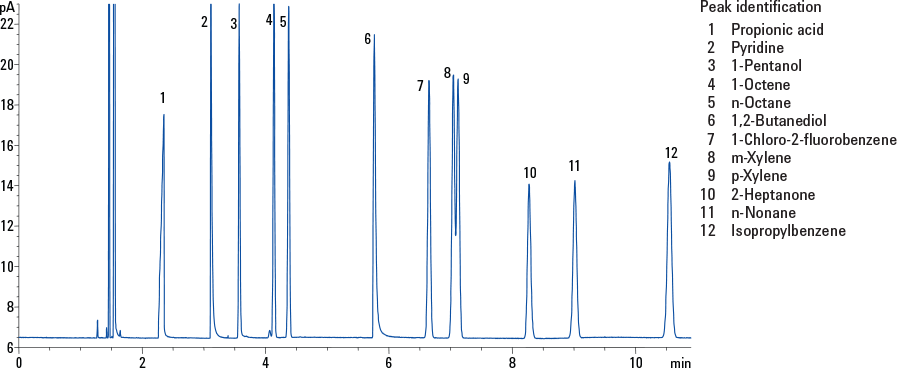Access Agilent eNewsletter January 2016

Improved peak shapes for active semivolatiles with inert Agilent J&W DB-UI 8270D columns
Ken Lynam, Agilent R&D/Applications Chemist
Each day, a wide range of volatile and semivolatile contaminants are discharged into water sources around the world. These analytes are diverse in their boiling points and chemical activity. Some incorporate active chemical moieties, including basic, acidic, and phosphorus-containing functional groups that can create complications for chromatography. Analytes with these functional groups may adsorb on active sites anywhere in the flow path, which results in tailing peaks, higher detection limits, or in the worst case, nondetection of analytes.
Inert GC columns must be specifically designed to meet the demands of these active and often problematic analytes. Inertness verification testing is necessary to deliver sharp peaks, low limits of detection, and reliable system performance. That is why each Agilent J&W DB-UI 8270D Ultra Inert GC column is factory-tested to ensure sharp peaks and low detection limits for active semivolatile compounds.

Figure 1. Example test chromatogram shows good peak shapes for semivolatiles run on an Agilent J&W DB-UI 8270D column.
Ultra Inert testing uses demanding probes
A test mix designed specifically for the Agilent J&W DB-UI 8270D column includes critical test probes relevant for semivolatile analysis. To thoroughly evaluate inertness, tests are done under the particularly stringent conditions of both low concentration (5-10 ng/component on column) and low isothermal temperature (45 °C). Figure 1 shows a typical test chromatogram for a DB-UI 8270D column. Test results from individual columns include chromatograms that provide proof of inertness with every column shipped.
Inlet liner deactivation is another critical step to maximize reliable system performance for semivolatile analysis. Agilent Ultra Inert liners are also tested with demanding test probes to provide superior inertness and better peak shapes than traditionally deactivated inlet liners. New deactivation strategies enable the use of Ultra Inert liners with glass wool for successful analyses of active acidic, basic, and organophosphorus analytes.
Two GC/MSD systems used to evaluate column quality
In a recent study to evaluate GC column performance, we used two GC/MSD systems. GC/MSD System 1 used a 30 m Г— 0.25 mm, 0.25 µm Agilent J&W DB-UI 8270D column to analyze an AccuStandard 78-component mix with nominal concentrations of 10 ng/µL per analyte.
GC/MSD System 2 used a 20 m Г— 0.18 mm, 0.36 µm DB-UI 8270D column with a 29-component mix at a nominal concentration of 10 ng/µL per analyte.

Figure 2. Example total ion chromatogram shows well-shaped peaks for a 78-component semivolatile standard at 10 ng on-column loading for each component. Figure courtesy of Jeffery S Hollis, AnalySense, Sacramento CA.

Figure 3. Example chromatogram shows well-behaved peaks for a 29-component mix on an Agilent J&W DB-UI 8270D capillary GC column, 20 m Г— 0.18 mm, 0.36 µm.
Outstanding peak shapes for demanding test probes
Figure 2 shows the GC/MSD analysis of the AccuStandard 78-component semivolatile mixture on a 30 m Г— 0.25 mm, 0.25 µm Agilent J&W DB-UI 8270D column. In less than 24 minutes, all peaks of interest were identified and quantified, with outstanding peak shapes. The acidic component pentachlorophenol gave excellent peak shapes with USP peak tailing factors below 1.3.
Figure 3 depicts the resolution of the 29-component Agilent GC/MS Semivolatile Analyzer Checkout Mix with exceptional peak shapes for all components at the 10 ng level. This analysis required less than 16 minutes, even though this mix represents a wide cross-section of analytes with boiling points that range from N-nitrosodimethylamine to perylene-d12. We observed sharp symmetrical peaks for both the early eluting N-nitrosodimethylamine and the late eluting perylene-d12.
The 29 component mix contains a wide range of chemically active analytes including acidic phenols, organic bases, and organophosphorus and organochlorine pesticides. 2,4-Dinitrophenol, 4-nitrophenol, and pentachlorophenol all show excellent peak shape and response on this system with an Agilent J&W DB-UI 8270D column and an Agilent Ultra Inert liner with glass wool.
Additional tests prove liner provides low surface activity
Organochlorine pesticides like DDT and endrin break down in response to surface activity, particularly in the inlet. After a series of more than 100 solvent blank and standard injections, endrin and DDT breakdown products were below 1.5% of the total area for their parent peaks. Organophosphorus pesticides such as mevinphos, simazine, atrazine, and terbufos can also show peak tailing due to interactions in the liner. An Agilent Ultra Inert liner with glass wool produced excellent peak shapes even for these challenging pesticides.
Column and liner well-suited for active analytes
Agilent J&W DB-UI 8270D columns deliver robust semivolatile analyses in both 0.25 mm and 0.18 mm inside diameter formats. Both columns produce excellent peak shapes for active analytes—including acidic phenols, organic bases, endrin, DDT, and organophosphorus pesticides. In the example with the 0.18 mm id column, an Agilent Ultra Inert liner with glass wool showed very low endrin and DDT breakdown. The analysis yielded sharp symmetrical peaks for the organophosphorus compounds in the 29-component semivolatiles analyzer mix.
If you are challenged to analyze pesticides that are troublesome to chromatograph, download Agilent Application Note 5991-0250EN for many more details about this study, including expanded views of challenging portions of chromatograms and a customer opinion about the column. Then learn more about Agilent Ultra Inert capillary columns.
Stay informed about the applications that are important to you
Subscribe to Access Agilent
Our free customized
monthly eNewsletter
Article Directory – January 2016
All articles in this issue
-
 What is in your beer? Find out using a Agilent J&W DB-624 Ultra Inert (UI) column with GC/MS static headspace solution
What is in your beer? Find out using a Agilent J&W DB-624 Ultra Inert (UI) column with GC/MS static headspace solution -
 Moving biologics to market with automated biopharma workflow solution
Moving biologics to market with automated biopharma workflow solution -
 Nobel Prize-winning lab uses Agilent equipment to accelerate natural product discoveries
Nobel Prize-winning lab uses Agilent equipment to accelerate natural product discoveries -
 Tip: How to detect leachables from drug container closures in pharmaceutical products
Tip: How to detect leachables from drug container closures in pharmaceutical products -
 Fast, accurate absolute-quantification of proteins and antibodies with Agilent 8800 ICP-QQQ
Fast, accurate absolute-quantification of proteins and antibodies with Agilent 8800 ICP-QQQ -
 Chevron and Agilent collaborate on new multi-element crude oil analysis technology that delivers advantages in speed, cost, and safety
Chevron and Agilent collaborate on new multi-element crude oil analysis technology that delivers advantages in speed, cost, and safety -
 Ask the Expert: Can I improve the chromatography of basic compounds on my older HPLC systems?
Ask the Expert: Can I improve the chromatography of basic compounds on my older HPLC systems? -
 More pesticides identified using Agilent Pesticide DRS Screening GC/MSD Analyzer with new high efficiency source
More pesticides identified using Agilent Pesticide DRS Screening GC/MSD Analyzer with new high efficiency source -
 Improved peak shapes for active semivolatiles with inert Agilent J&W DB-UI 8270D columns
Improved peak shapes for active semivolatiles with inert Agilent J&W DB-UI 8270D columns
Figure 1

Example test chromatogram shows good peak shapes for semivolatiles run on an Agilent J&W DB-UI 8270D column.
Figure 2

Example total ion chromatogram shows well-shaped peaks for a 78-component semivolatile standard at 10 ng on-column loading for each component. Figure courtesy of Jeffery S Hollis, AnalySense, Sacramento CA.
Figure 3

Example chromatogram shows well-behaved peaks for a 29-component mix on an Agilent J&W DB-UI 8270D capillary GC column, 20 m Г— 0.18 mm, 0.36 µm.